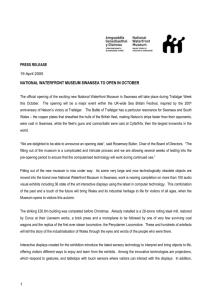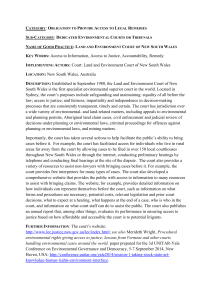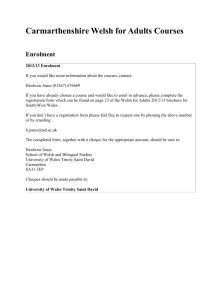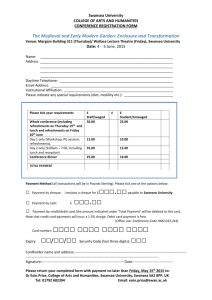Wales: The First Industrial Nation?
advertisement
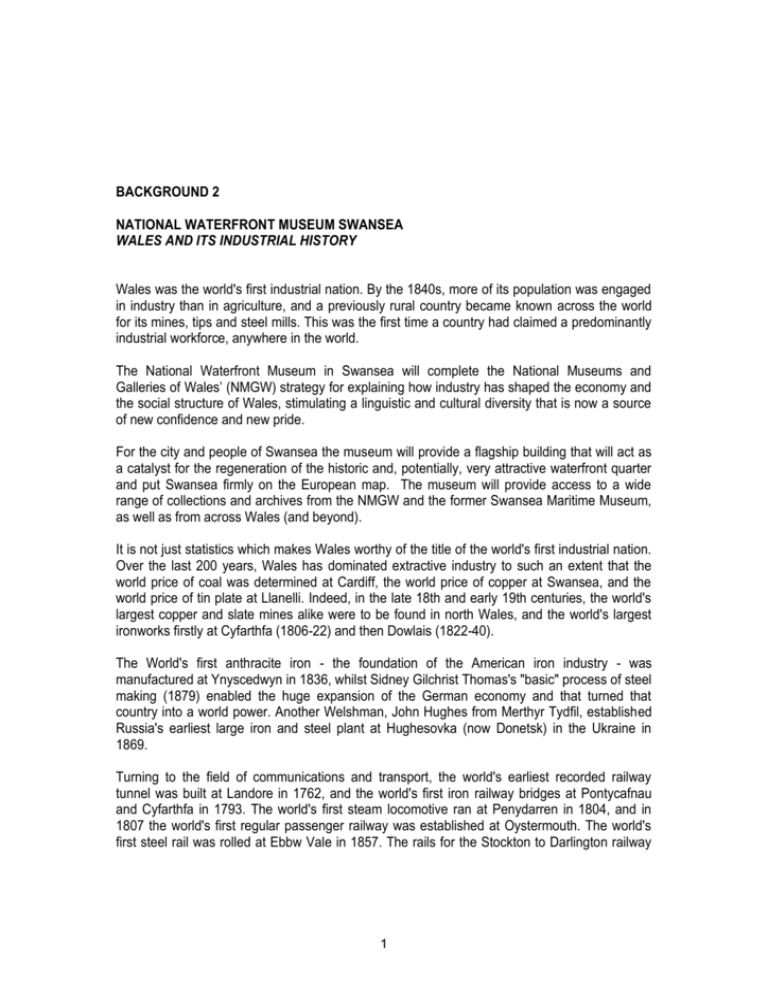
BACKGROUND 2 NATIONAL WATERFRONT MUSEUM SWANSEA WALES AND ITS INDUSTRIAL HISTORY Wales was the world's first industrial nation. By the 1840s, more of its population was engaged in industry than in agriculture, and a previously rural country became known across the world for its mines, tips and steel mills. This was the first time a country had claimed a predominantly industrial workforce, anywhere in the world. The National Waterfront Museum in Swansea will complete the National Museums and Galleries of Wales’ (NMGW) strategy for explaining how industry has shaped the economy and the social structure of Wales, stimulating a linguistic and cultural diversity that is now a source of new confidence and new pride. For the city and people of Swansea the museum will provide a flagship building that will act as a catalyst for the regeneration of the historic and, potentially, very attractive waterfront quarter and put Swansea firmly on the European map. The museum will provide access to a wide range of collections and archives from the NMGW and the former Swansea Maritime Museum, as well as from across Wales (and beyond). It is not just statistics which makes Wales worthy of the title of the world's first industrial nation. Over the last 200 years, Wales has dominated extractive industry to such an extent that the world price of coal was determined at Cardiff, the world price of copper at Swansea, and the world price of tin plate at Llanelli. Indeed, in the late 18th and early 19th centuries, the world's largest copper and slate mines alike were to be found in north Wales, and the world's largest ironworks firstly at Cyfarthfa (1806-22) and then Dowlais (1822-40). The World's first anthracite iron - the foundation of the American iron industry - was manufactured at Ynyscedwyn in 1836, whilst Sidney Gilchrist Thomas's "basic" process of steel making (1879) enabled the huge expansion of the German economy and that turned that country into a world power. Another Welshman, John Hughes from Merthyr Tydfil, established Russia's earliest large iron and steel plant at Hughesovka (now Donetsk) in the Ukraine in 1869. Turning to the field of communications and transport, the world's earliest recorded railway tunnel was built at Landore in 1762, and the world's first iron railway bridges at Pontycafnau and Cyfarthfa in 1793. The world's first steam locomotive ran at Penydarren in 1804, and in 1807 the world's first regular passenger railway was established at Oystermouth. The world's first steel rail was rolled at Ebbw Vale in 1857. The rails for the Stockton to Darlington railway 1 were made at Ebbw Vale, those for the Manchester to Liverpool line at Penydarren, and Dowlais-made rails made possible the opening up of the American mid-West and Siberia alike. The Royal Navy's decision to rely exclusively on Welsh steam coal meant that the growth and maintenance of the British Empire depended to a significant degree upon the output of Welsh miners and mariners. Cardiff became the world's foremost coal-exporting port until it was supplanted by its close neighbour and rival Barry, and much of the British merchant marine depended upon Welsh captains and crews throughout the 19th and early 20th centuries. More recently, Wales has led the way in the process of de-industrialisation; the work of the Welsh Development Agency in reclaiming derelict land is admired throughout the world, whilst a strategy for inward investment has been similarly effective. This apart, however, postindustrial Wales is generally an impoverished society, in need of rebuilding its entrepreneurship and self esteem. The National Waterfront Museum, Swansea, opening in the summer of 2005, will play an important role in this process. More information (public) : www.waterfrontmuseum.co.uk NOTES FOR EDITORS: (1) TIMETABLE: Late October/Early November 2004: Building handed over; opportunities for tours by architectural correspondents. (Contact Caro Communications or Sarah Vining Smith – see below) January 2005: Details of the exhibition design by Land Studio Design will be released; Education Zone on the website will be launched, photographs of parts of the interior will be available. May 2005: Exhibition fit out nears completion – opportunity for press views. More information on Public Art outside the Museum, shops and catering will be provided. Summer 2005: The Museum opens to the public (date to be confirmed). (2) PHOTOGRAPHS Contact Caro Communications for architectural photographs of the building. Contact Sarah Vining or Ylva French for photographs of a small selection of objects which will be featured in the exhibition. (From January more photographs will be available). (3) MEDIA CONTACTS 2 National Waterfront Museum: Sarah Vining Marketing and Communications Manager Tel: 01792 459640 Fax: 01792 459641 Email: sarah.vining-smith@swansea.gov.uk Ylva French Consultancy Tel. 020 7 233 6789 Email: ylva@ylvafrench.co.uk Shely Bryan, Caro Communications (for Wilkinson Eyre Architects) Tel. 020 7336 8488 Email: shely@carocommunications.com Gwenllian Carr Head of Press and PR, National Museums and Galleries of Wales Tel: 029 2057 3175 Email: gwenllian.carr@nmgw.ac.uk Lee Wenham Head of Communications, City and County of Swansea Email: lee.wenham@swansea.gov.uk (4) BACKGROUND INFORMATION Background 1: National Waterfront Museum – the project and plans in detail Background 2: Wales and its Industrial history September 2004 3

